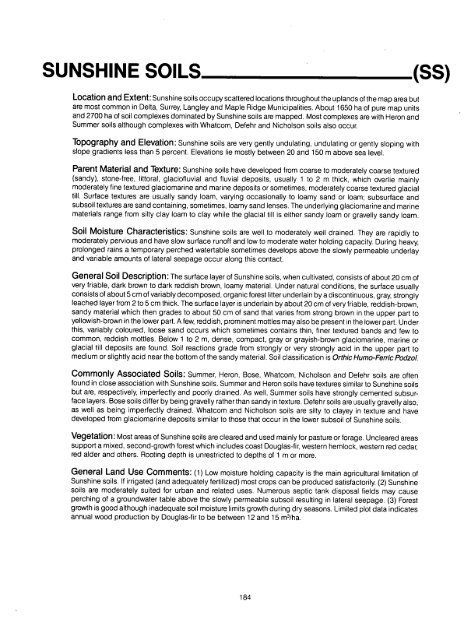Soils of the - Agriculture and Agri-Food Canada
Soils of the - Agriculture and Agri-Food Canada
Soils of the - Agriculture and Agri-Food Canada
Create successful ePaper yourself
Turn your PDF publications into a flip-book with our unique Google optimized e-Paper software.
SUNSHINE SOILS (SS)<br />
Location <strong>and</strong> Extent : Sunshine soils occupy scattered locations throughout <strong>the</strong> upl<strong>and</strong>s <strong>of</strong> <strong>the</strong> map area bu t<br />
are most common in Delta, Surrey, Langley <strong>and</strong> Maple Ridge Municipalities . About 1650 ha <strong>of</strong> pure map unit s<br />
<strong>and</strong> 2700 ha <strong>of</strong> soil complexes dominated by Sunshine soils are mapped . Most complexes are with Heron an d<br />
Summer soils although complexes with Whatcom, Defehr <strong>and</strong> Nicholson soils also occur .<br />
Topography <strong>and</strong> Elevation : Sunshine soils are very gently undulating, undulating or gently sloping wit h<br />
slope gradients less than 5 percent . Elevations lie mostly between 20 <strong>and</strong> 150 m above sea level .<br />
Parent Material <strong>and</strong> Texture : Sunshine soils have developed from coarse to moderately coarse texture d<br />
(s<strong>and</strong>y), stone-free, littoral, glaci<strong>of</strong>luvial <strong>and</strong> fluvial deposits, usually 1 to 2 m thick, which overlie mainl y<br />
moderately fine textured glaciomarine <strong>and</strong> marine deposits or sometimes, moderately coarse textured glacia l<br />
till . Surface textures are usually s<strong>and</strong>y loam, varying occasionally to loamy s<strong>and</strong> or loam ; subsurface an d<br />
subsoil textures are s<strong>and</strong> containing, sometimes, loamy s<strong>and</strong> lenses . The underlying glaciomarine <strong>and</strong> marin e<br />
materials range from silty clay loam to clay while <strong>the</strong> glacial till is ei<strong>the</strong>r s<strong>and</strong>y loam or gravelly s<strong>and</strong>y loam .<br />
Soil Moisture Characteristics : Sunshine soils are well to moderately well drained . They are rapidly t o<br />
moderately pervious <strong>and</strong> have slow surface run<strong>of</strong>f <strong>and</strong> low to moderate water holding capacity. During heavy,<br />
prolonged rains a temporary perched watertable sometimes develops above <strong>the</strong> slowly permeable underla y<br />
<strong>and</strong> variable amounts <strong>of</strong> lateral seepage occur along this contact .<br />
General Soil Description : The surface layer <strong>of</strong> Sunshine soils, when cultivated, consists <strong>of</strong> about 20 cm o f<br />
very friable, dark brown to dark reddish brown, loamy material . Under natural conditions, <strong>the</strong> surface usually<br />
consists <strong>of</strong> about 5 cm <strong>of</strong> variably decomposed, organic forest litter underlain by a discontinuous, gray, strongl y<br />
leached layer from 2 to 5 cm thick . The surface layer is underlain by about 20 cm <strong>of</strong> very friable, reddish-brown ,<br />
s<strong>and</strong>y material which <strong>the</strong>n grades to about 50 cm <strong>of</strong> s<strong>and</strong> that varies from strong brown in <strong>the</strong> upper part t o<br />
yellowish-brown in <strong>the</strong> lower part . A few, reddish, prominent mottles may also be present in <strong>the</strong> lower part . Unde r<br />
this, variably coloured, loose s<strong>and</strong> occurs which sometimes contains thin, finer textured b<strong>and</strong>s <strong>and</strong> few t o<br />
common, reddish mottles. Below 1 to 2 m, dense, compact, gray or grayish-brown glaciomarine, marine o r<br />
glacial till deposits are found . Soil reactions grade from strongly or very strongly acid in <strong>the</strong> upper part t o<br />
medium or slightly acid near <strong>the</strong> bottom <strong>of</strong> <strong>the</strong> s<strong>and</strong>y material . Soil classification is Orthic Humo-Ferric Podzol.<br />
Commonly Associated <strong>Soils</strong> : Summer, Heron, Bose, Whatcom, Nicholson <strong>and</strong> Defehr soils are <strong>of</strong>te n<br />
found in close association with Sunshine soils . Summer <strong>and</strong> Heron soils have textures similar to Sunshine soil s<br />
but are, respectively, imperfectly <strong>and</strong> poorly drained . As well, Summer soils have strongly cemented subsurface<br />
layers . Bose soils differ by being gravelly ra<strong>the</strong>r than s<strong>and</strong>y in texture . Defehr soils are usually gravelly also ,<br />
as well as being imperfectly drained . Whatcom <strong>and</strong> Nicholson soils are silty to clayey in texture <strong>and</strong> hav e<br />
developed from glaciomarine deposits similar to those that occur in <strong>the</strong> lower subsoil <strong>of</strong> Sunshine soils .<br />
Vegetation : Most areas <strong>of</strong> Sunshine soils are cleared <strong>and</strong> used mainly for pasture or forage . Uncleared area s<br />
support a mixed, second-growth forest which includes coast Douglas-fir, western hemlock, western red cedar ,<br />
red alder <strong>and</strong> o<strong>the</strong>rs . Rooting depth is unrestricted to depths <strong>of</strong> 1 m or more .<br />
General L<strong>and</strong> Use Comments : (1) Low moisture holding capacity is <strong>the</strong> main agricultural limitation o f<br />
Sunshine soils . If irrigated (<strong>and</strong> adequately fertilized) most crops can be produced satisfactorily . (2) Sunshin e<br />
soils are moderately suited for urban <strong>and</strong> related uses . Numerous septic tank disposal fields may caus e<br />
perching <strong>of</strong> a groundwater table above <strong>the</strong> slowly permeable subsoil resulting in lateral seepage . (3) Forest<br />
growth is good although inadequate soil moisture limits growth during dry seasons . Limited plot data indicates<br />
annual wood production by Douglas-fir to be between 12 <strong>and</strong> 15 m 3/ha .<br />
184

















